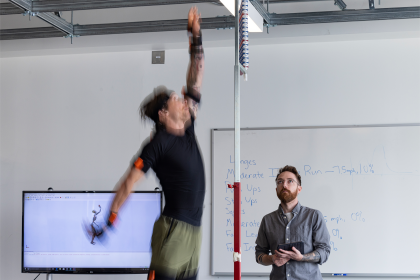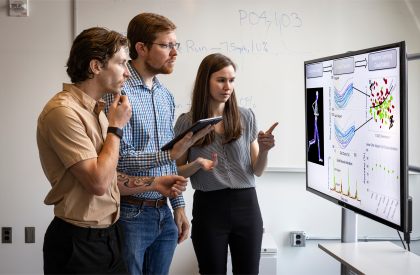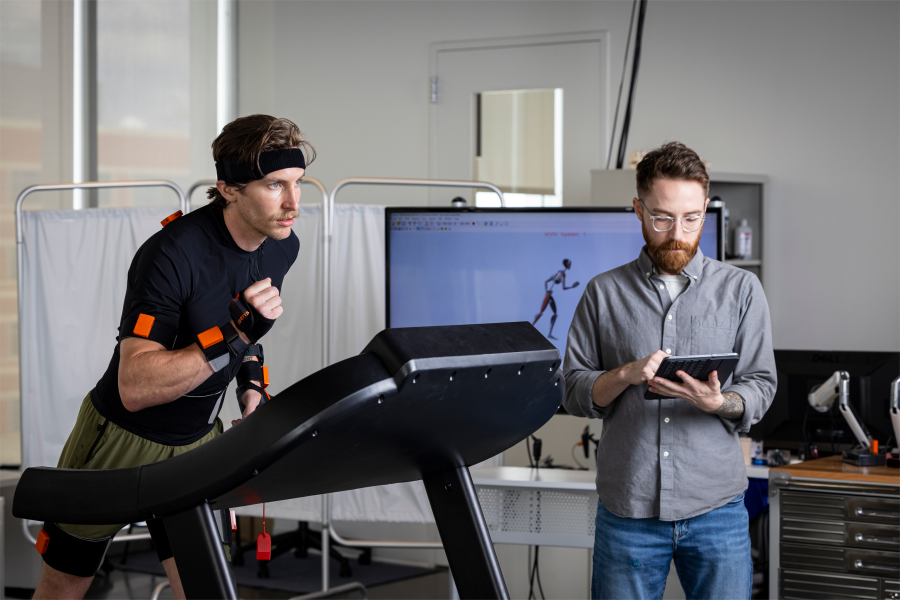Musculoskeletal, or MSK, injuries account for the overwhelming majority of injuries in the military—up to 82% in the U.S. Army, by some estimates—and 59% of all limited-duty days, according to 2019 statistics. These injuries are often preceded by physical fatigue, a natural consequence of performing strenuous activity, particularly under heavy and irregular loads.
Scientists at the Johns Hopkins Applied Physics Laboratory are working on a system to monitor physical fatigue in near-real time. Such a capability could prevent countless MSK injuries, and fits into a larger portfolio of work at the laboratory focused on predictive health and human performance modeling.
"We see a high incidence of MSK injuries in the Department of Defense year over year, but physical fatigue, which is a common precursor to those injuries, often goes underreported," said David Drewry III, who manages a research portfolio dedicated to Army operational readiness at APL. "In part, that's unavoidable because it's in the nature of military culture to push through the pain and keep working. So there is a real need for objective, quantitative methods to assess whether someone is getting fatigued to the point that they've become susceptible to an injury."
Biomechanical engineer Mike Vignos is leading an effort, currently in its second year, to create machine learning algorithms that use wearable sensor data to reliably identify and quantify the severity of physical fatigue. The long-term goal is to use this information to predict the risk of MSK injury in near-real time and identify those at high risk for injury before it occurs.
One of the most significant challenges to creating such algorithms is acquiring the data to train them. While previous research suggests an association between fatigue and MSK injury, this relationship has not been quantified. This is due, in part, to the inability to re-create these injuries in the laboratory.
To address this challenge, Vignos and his team—which includes Marshall Tumperi, Connor Pyles, Nikki Steiner, John Clark, Melissa Dunphy, Bryndan Lindsey, Jason Lee, and Korine Ohiri—are drawing on past and parallel APL studies to produce computational models of the human body, as well as a compilation of data that correlates injuries with the environments in which they occur.
The other key piece of this study involves gathering information from individual soldiers that will indicate whether they are fatigued. Vignos and his team are still in the process of identifying the optimal sensor suite—one that will provide the necessary data without proving too cumbersome for already encumbered soldiers.
"Right now we're still in the 'over-sensorized' phase, since we're in the laboratory where we can afford to put five or six different sensors on people. But in the field there won't be a scenario where that's a realistic option," Vignos said. "We're still working out what that sweet spot is, that minimally viable sensor setup of ideally one or maybe two wearable sensors that will allow us to assess fatigue without contributing to the problem we're trying to solve. We're also exploring the option of doing this completely with remote sensing, which would be ideal because it removes the need for warfighters to wear sensors."

Image caption: Lindsey observes a pilot test of a maximum vertical jump. Participants’ maximum vertical jump is tested throughout the exercise protocol as one method of monitoring their fatigue level.
Image credit: Johns Hopkins APL/Ed Whitman
Last year, the team determined that electromyography, or muscle activation, metrics correlate most strongly with physical fatigue, with kinematics (movement and impact) and heart rate data providing some additional benefit. By collecting and analyzing data on 10 subjects running on treadmills, they were able to create an algorithm that can identify fatigue in simple binary terms: fatigued versus not fatigued. In this year's effort, they are aiming to create a numerical score that can be used to quantify fatigue with more precision.
"If we can monitor fatigue across a continuum, that opens up the possibility of mapping levels of fatigue to risks of particular injuries. This would allow for interventions or steps to be taken to prevent those injuries before they occur," Vignos said.
This year's study is collecting data on a similar number of subjects but is looking at a wider range of physical movements, including treadmill running and bodyweight exercises such as pushups, squats, and lunges.
"Besides capturing data on a wider range of operationally relevant movements, we are also including a combination of aerobic cardiovascular work and anaerobic muscular work," Vignos explained. "Our goal is to create a score that is generalizable across all these drivers of physical fatigue and that enables us to reliably predict and prevent MSK injuries that might otherwise take soldiers out of the line of duty."

Image caption: The analysis team—(from left) John Clark, Jason Lee and Nikki Steiner—discuss the workflow used to classify physical fatigue from measurements of an individual's physiology and biomechanics. In this specific workflow, they are considering the individual's movement patterns and muscle activity.
Image credit: Johns Hopkins APL/Ed Whitman
Kathleen Perrino, who manages an APL research portfolio dedicated to predictive health, said that injury prevention informed by a fatigue score might take many forms.
"Once we're armed with an objective score for physical fatigue, there are a variety of ways we could apply it to improve the health of our warfighters," Perrino said. "We might change the armor that they wear, or the way their gear is distributed across their bodies. We might combine the score with knowledge about how a person's genetic predispositions affect their biomechanics, and so individualize how people are trained and equipped. There are any number of ways it could be applied, which is exciting, as well as challenging."
Looking further ahead, Perrino and Vignos see this work connecting with other ongoing research at APL focused on quantifying fatigue and assessing its effects on performance. This portfolio extends well beyond physical fatigue, encompassing work studying and modeling cognitive fatigue and sleep deprivation, with the ultimate goal of developing a comprehensive suite of tools for real-time human-state estimation and predictive health.
"In the real world, there is no hard distinction between physical fatigue and mental or cognitive fatigue," said Vignos. "Think of a common military task like reconnaissance, where if you want to assess a person's potential performance, you need to understand the interplay of physical and cognitive fatigue, as well as the effects of other factors like sleep deprivation and caffeine intake. That's where this work gets really interesting, and where it's headed in the long term."
Posted in Health, Science+Technology
Tagged applied physics laboratory, military, injuries










